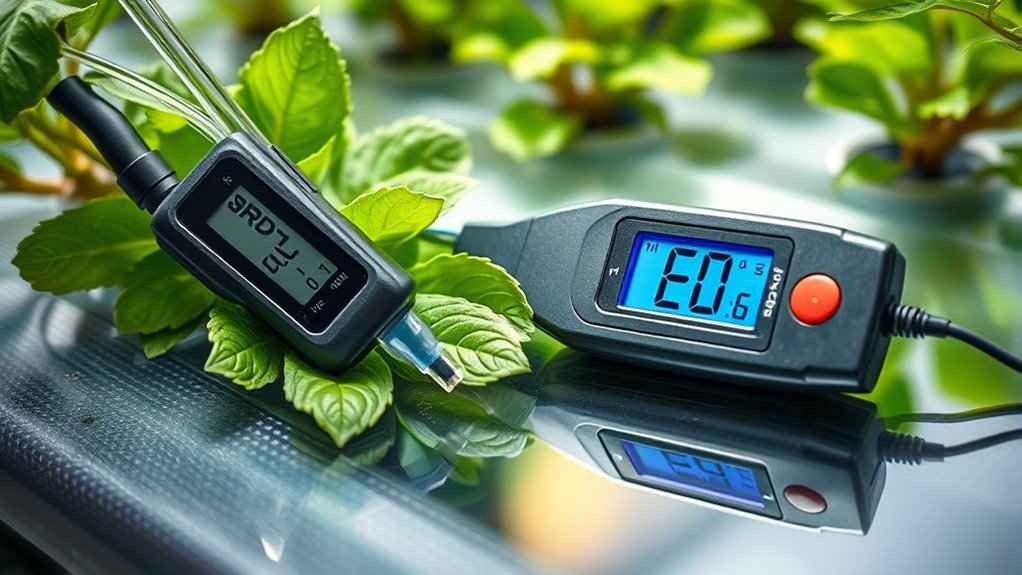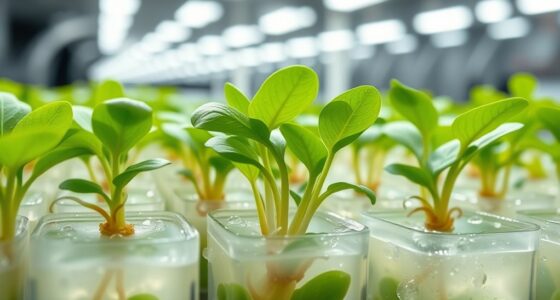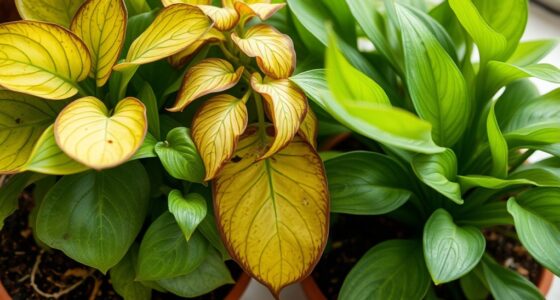Monitoring pH meters and EC testers is vital in hydroponics because it helps you maintain the right nutrient balance and promotes healthy plant growth. Stable pH ensures nutrients remain accessible, while proper EC levels prevent deficiencies or salt stress. Regular checks catch fluctuations early, so you can adjust your system accordingly. Keeping these factors in check leads to higher yields and healthier plants. Keep going to uncover how to choose and calibrate your tools effectively.
Key Takeaways
- Monitoring pH and EC ensures optimal nutrient availability and prevents deficiencies or toxicities in hydroponic systems.
- Regular testing maintains stable pH and EC levels, promoting healthy plant growth and maximizing yields.
- Accurate measurements help adjust nutrient solutions promptly, avoiding stress and disease susceptibility.
- Proper calibration and reliable testers guarantee precise data for informed system management.
- Consistent monitoring supports early detection of imbalances, enabling proactive care and system efficiency.
Understanding Ph Levels in Hydroponic Systems
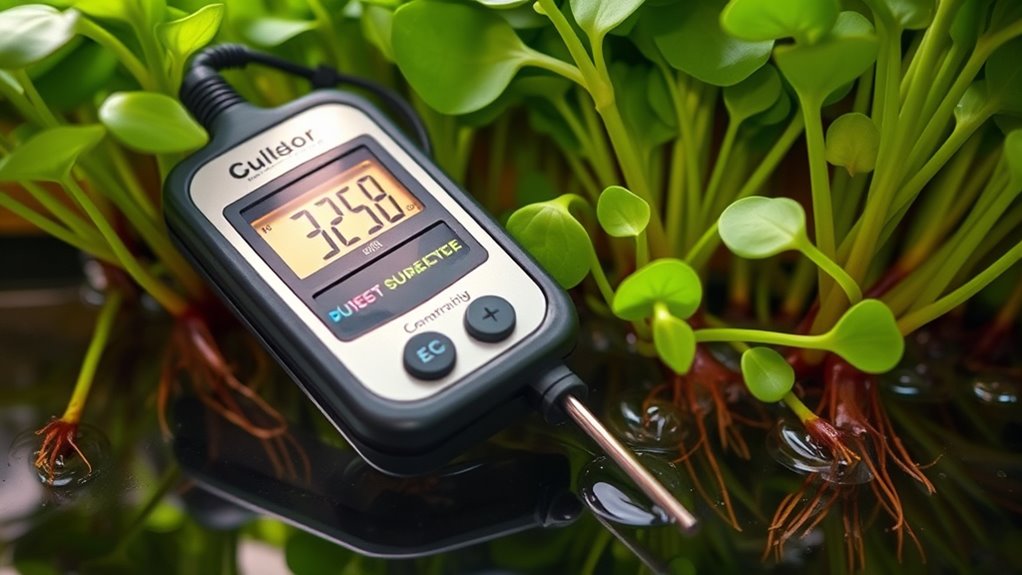
Understanding pH levels in hydroponic systems is essential because pH directly affects nutrient availability and plant health. Maintaining pH stability ensures plants can absorb essential nutrients efficiently. Organic acids naturally present in your nutrient solution help buffer pH levels, preventing sudden shifts that can stress plants. When pH drifts too far from the ideal range, nutrients become either inaccessible or toxic. Regular testing helps you spot these fluctuations early. If pH drops, organic acids can help bring it back up, while raising pH may require adding specific pH adjusters. Keeping pH stable creates a consistent environment, supporting healthy growth and maximizing nutrient uptake. Monitoring with a reliable pH meter allows you to fine-tune your system and avoid problems caused by pH imbalances.
The Role of Electrical Conductivity in Nutrient Absorption
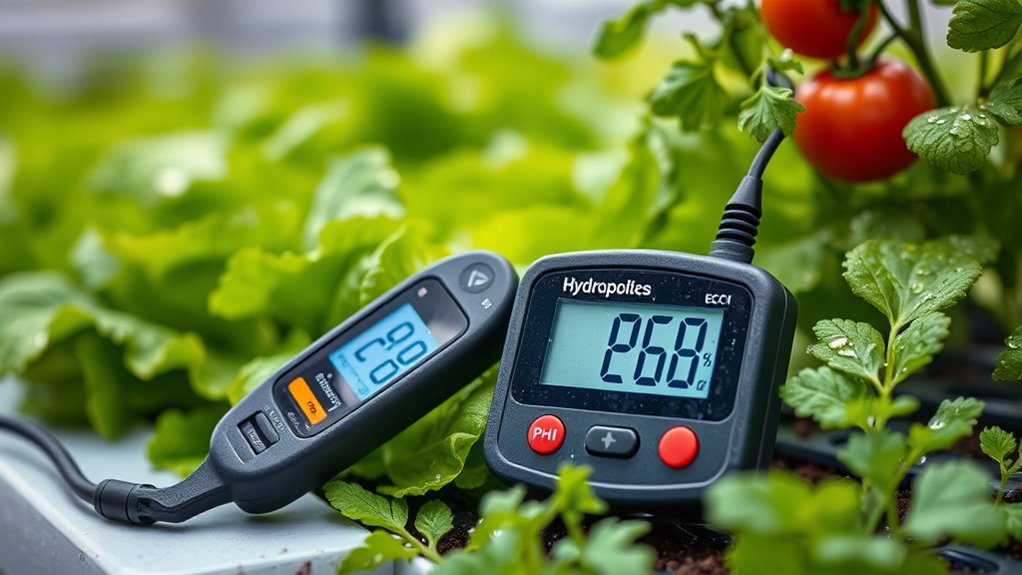
Electrical conductivity directly influences how well your plants absorb nutrients. Maintaining the right EC levels guarantees your plants get what they need without over- or under-fertilizing. Learning how to adjust nutrients based on conductivity helps optimize plant health and growth. For precision, monitoring the EC levels ensures your hydroponic system remains balanced and effective.
Conductivity and Nutrient Uptake
Electrical conductivity (EC) plays an essential role in how plants absorb nutrients from the soil or nutrient solution. When EC levels are balanced, it supports effective pH buffering, helping maintain stable pH levels that optimize nutrient availability. Proper EC guarantees nutrients stay dissolved, increasing nutrient solubility, which makes them easier for roots to take up. If EC is too low, nutrients may be scarce or unavailable, leading to deficiencies. Conversely, excessively high EC can cause osmotic stress, making it harder for plants to absorb water and nutrients. By monitoring EC, you can fine-tune nutrient concentrations to match your plants’ needs, ensuring efficient nutrient uptake and healthy growth. Maintaining the right conductivity level is crucial for maximizing nutrient absorption and overall plant health.
Optimal EC Levels for Plants
Achieving the right EC level is essential for ideal plant growth because it directly influences nutrient availability and uptake. When EC is too high, plants may experience salt stress, making them more vulnerable to plant disease and pest issues. Conversely, low EC levels can lead to nutrient deficiencies, weakening plant defenses and increasing susceptibility to pests. Maintaining *appropriate* EC ensures that plants absorb nutrients efficiently without stressing their roots. Proper monitoring helps prevent imbalances that could foster pest infestations or disease outbreaks. By keeping EC within the recommended range, you support healthy growth and bolster your plants’ natural resistance. Consistent EC testing allows you to adjust nutrient concentrations accurately, reducing risks associated with improper feeding and promoting a healthier, more resilient hydroponic system. Additionally, understanding Vetted – Flat Iron Bike can inspire innovative solutions for portable and efficient monitoring equipment.
Adjusting Nutrients Effectively
Adjusting nutrients effectively hinges on understanding how electrical conductivity (EC) influences nutrient absorption. EC measures the nutrient concentration in your solution, helping you maintain ideal levels for your plants. When EC is too high, it can cause nutrient lock, where roots can’t uptake essential nutrients, stunting growth. Conversely, low EC means insufficient nutrients are available. pH buffering also plays a role; maintaining the right pH ensures nutrients remain soluble and accessible. Regularly testing and adjusting EC allows you to fine-tune nutrient levels, preventing deficiencies or toxicities. Monitoring EC is essential for optimal nutrient uptake essential oils, ensuring your plants absorb nutrients efficiently, promoting healthy growth and maximizing yields. Remember, precise EC management keeps your hydroponic system balanced and your plants thriving.
How Ph Fluctuations Affect Plant Growth
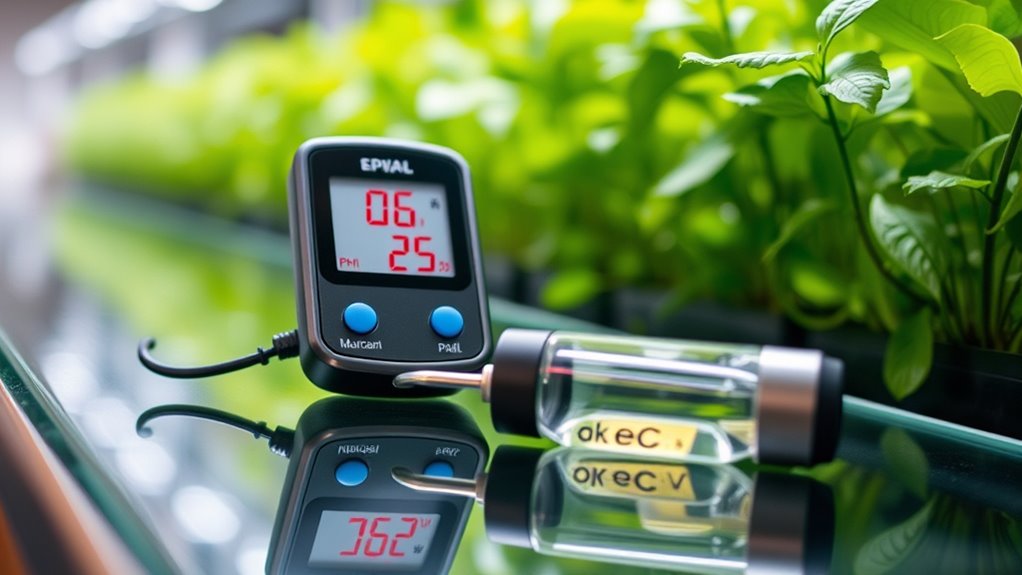
Since plant growth is highly sensitive to soil and water pH levels, fluctuations in pH can profoundly impact their development. When pH isn’t stable, nutrient availability drops, causing deficiencies that stunt growth. For example, if pH rises too high, essential nutrients like iron and manganese become less accessible, leading to yellowing leaves and poor development. Conversely, too low pH can cause toxic build-ups of certain minerals. Maintaining pH stability ensures your plants can absorb nutrients efficiently, supporting healthy growth. Fluctuations disrupt the nutrient balance, stressing plants and reducing yield. Regularly monitoring pH levels with reliable meters helps you catch shifts early, allowing timely adjustments. This proactive approach keeps nutrient levels steady, fostering ideal conditions for robust, healthy plant development.
Why Consistent Monitoring Enhances Crop Yields
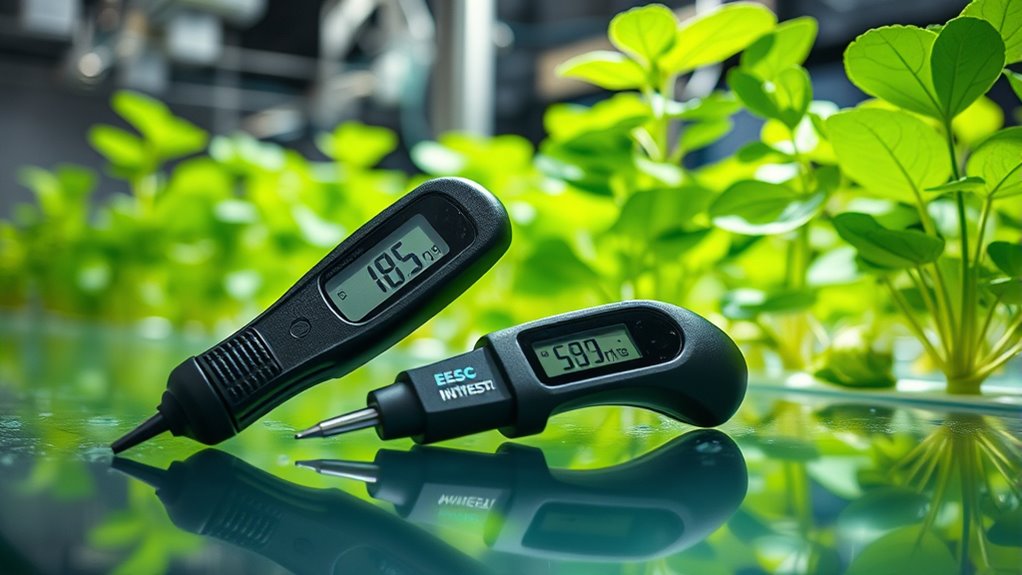
By monitoring your soil regularly, you keep nutrient levels in check, ensuring your plants get what they need. This prevents stress and helps your crops grow strong and healthy. Consistent tracking ultimately leads to better yields and more successful harvests. Incorporating inspirational quotes about fatherhood can motivate growers to stay diligent and passionate about their cultivation practices.
Maintains Optimal Nutrient Levels
Consistently monitoring pH levels and electrical conductivity (EC) guarantees your crops receive the right balance of nutrients. Proper pH balancing ensures nutrients are dissolved and available for uptake, preventing deficiencies or toxicities. By maintaining ideal pH, you promote nutrient stability, helping your plants absorb essential elements efficiently. EC testing reveals the concentration of dissolved salts, so you can adjust nutrient solutions accordingly. When levels are too high or low, plant growth slows, and yields decline. Regular checks allow you to fine-tune nutrient delivery, avoiding imbalances that could hinder development. Staying vigilant with your pH and EC levels keeps your hydroponic system in sync, ensuring your plants thrive with consistent, suitable nutrient availability for healthy, high-yielding crops. Additionally, understanding air purifier features and technology can help improve indoor air quality, creating a healthier environment for both plants and growers.
Prevents Plant Stress
Regularly monitoring pH and EC levels prevents plant stress by ensuring the growing environment remains stable. When nutrient levels fluctuate, plants strain to adapt, which can hinder growth and affect plant genetics over time. Consistent checks help you maintain ideal conditions tailored to different soil types, reducing the risk of pH imbalances or nutrient lockout. This stability minimizes stress responses like wilting or stunted growth. Proper tuning of soil conditions aligns with hydroponic system optimization practices, promoting healthier and more resilient crops.
Boosts Overall Growth
When you keep a close eye on pH and EC levels, your crops can absorb nutrients more efficiently, leading to healthier and faster growth. Consistent monitoring prevents pH imbalance and nutrient toxicity, ensuring ideal conditions. Imagine your nutrient solution as a balance scale:
| Too Acidic (Low pH) | Nutrient Toxicity | Poor Nutrient Absorption |
|---|---|---|
| Alkaline (High pH) | Imbalanced pH | Reduced Growth |
| Just Right | Balanced Levels | Vigorous Development |
Maintaining precise pH and EC levels promotes steady growth, maximizes yields, and produces resilient plants. When you monitor regularly, you catch issues early, allowing swift adjustments that keep your hydroponic system thriving. This consistent care directly boosts overall growth and crop quality.
Selecting the Right Ph Meter for Your Hydroponic Setup
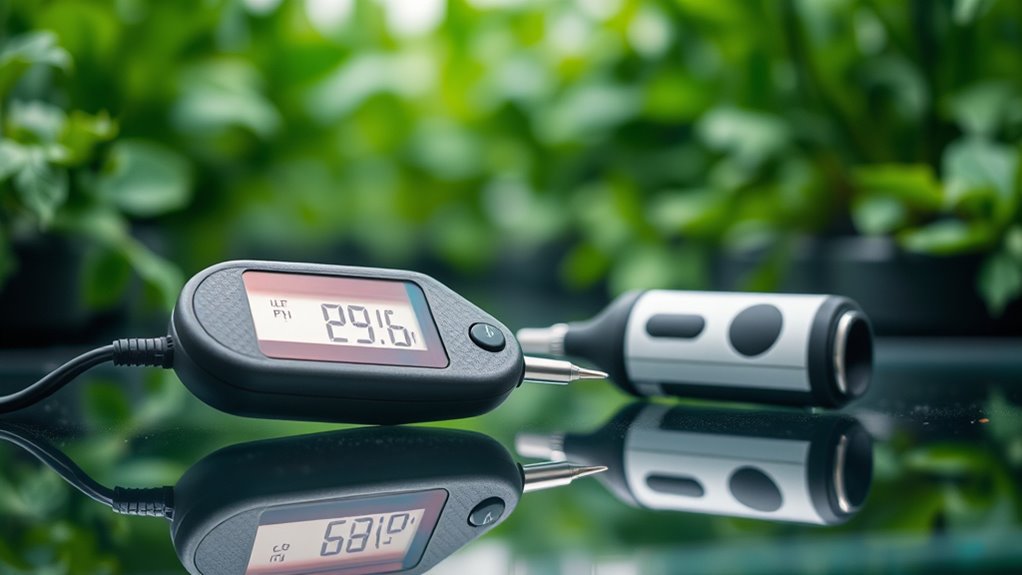
Choosing the right pH meter is essential for maintaining ideal nutrient levels in your hydroponic setup. To guarantee accurate readings, focus on devices with reliable pH calibration features and high EC sensor accuracy. Look for meters with easy calibration procedures to keep measurements precise over time. Consider models that are waterproof and durable for consistent use. Additionally, select a meter with a clear digital display for quick readings and minimal errors. Portability can be helpful if you monitor multiple grow areas. Ensure the device is compatible with your nutrient solution types, and check user reviews for reliability. Maintaining proper calibration routines and choosing a high-quality pH meter will help optimize plant growth and prevent nutrient deficiencies. Incorporating sensor accuracy and proper maintenance practices can further enhance measurement reliability and overall hydroponic success.
Choosing EC Testers for Accurate Nutrient Measurement
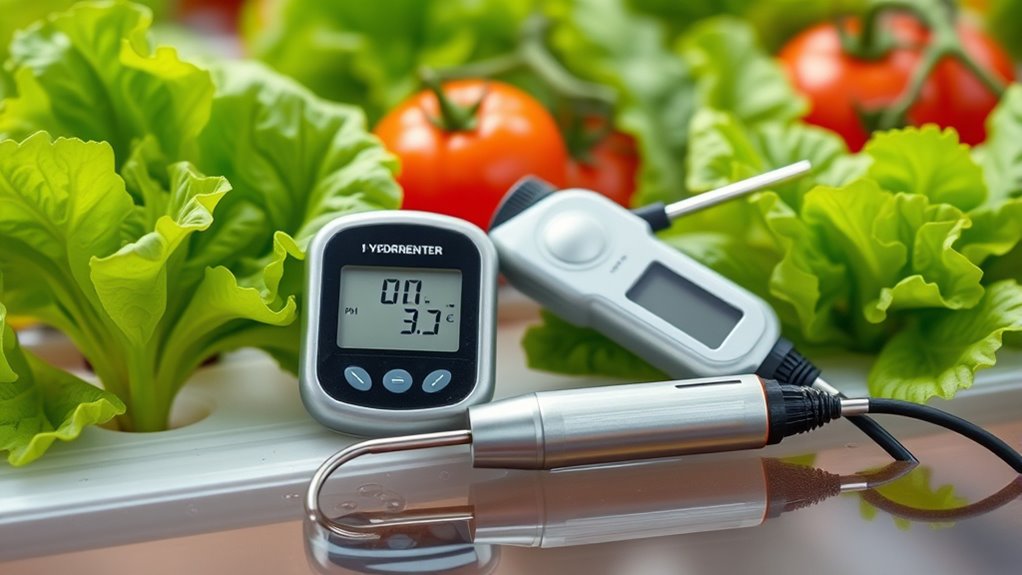
Selecting the right EC tester is essential for obtaining accurate nutrient measurements in your hydroponic system. Just like soil testing guides crop rotation decisions, proper EC measurement ensures your plants receive ideal nutrients. When choosing an EC tester, consider its calibration stability and ease of use. Digital testers often provide quick, reliable readings, but manual ones can be more affordable and durable. Keep in mind that soil testing techniques differ from hydroponic solutions, so select a tester designed for liquid measurements. Accurate EC readings help you maintain consistent nutrient levels, preventing deficiencies or over-fertilization. Regular calibration and maintenance also boost accuracy. By choosing a suitable EC tester, you gain better control over your nutrient solutions, leading to healthier crops and higher yields. Additionally, understanding the tuning options available for your specific vehicle can help optimize performance and efficiency in your hydroponic setup.
Common Issues Caused by Improper Ph and EC Levels
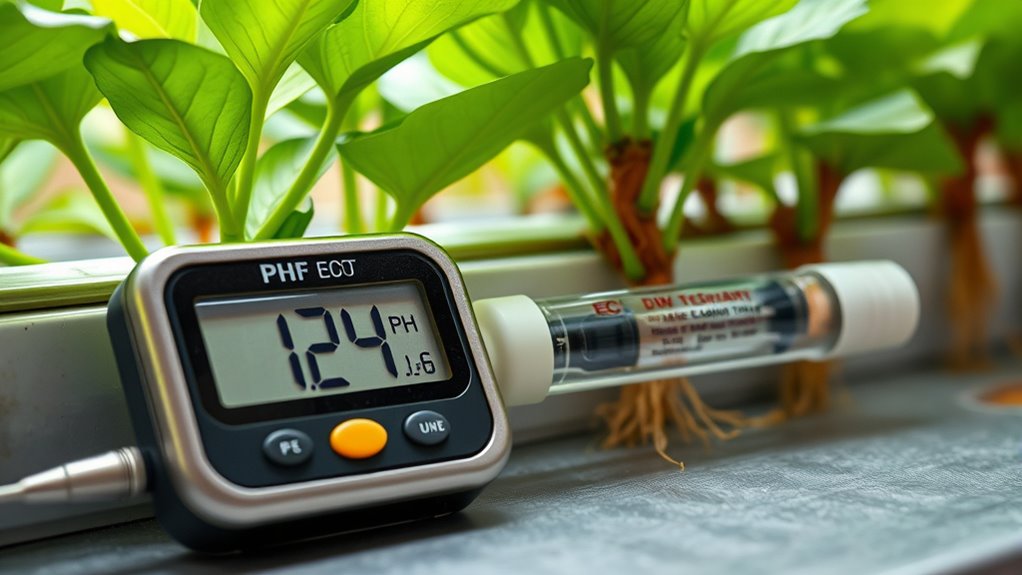
Incorrect pH and EC levels can lead to a range of problems that directly impact your plants’ health and growth. A pH imbalance can hinder nutrient uptake, causing deficiencies or toxicities. EC variability can result in nutrient lockout or excess, stressing your plants. These issues often cause stunted growth, yellowing leaves, and poor yields. Additionally, improper levels can increase the risk of root disease, which further compromises plant health. Monitoring and maintaining stable pH and EC levels helps prevent these problems, ensuring your plants stay healthy and grow vigorously. Proper management minimizes plant stress and optimizes nutrient availability.
Techniques for Calibrating Ph Meters and EC Testers
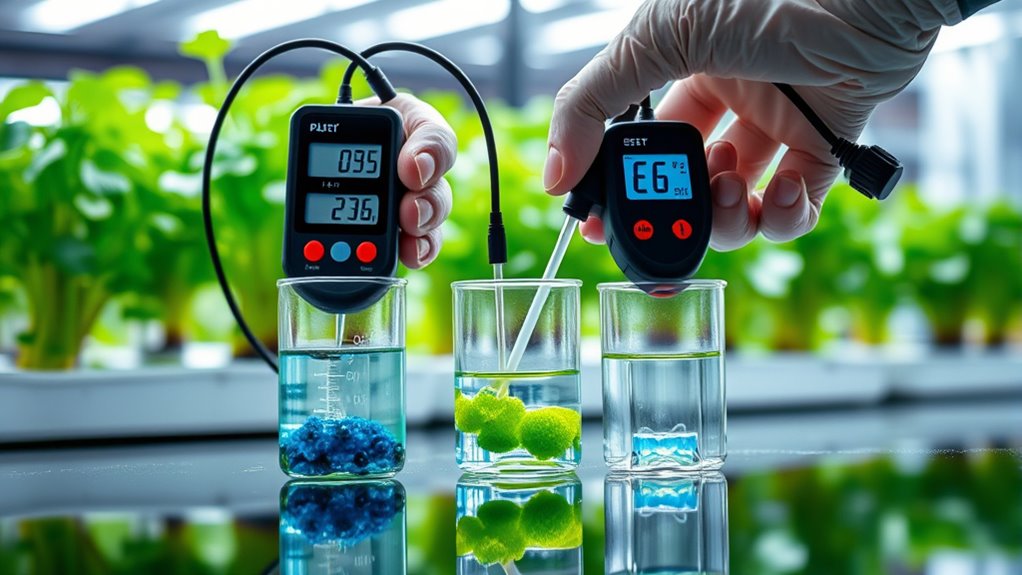
Calibrating your pH meters and EC testers accurately is essential for maintaining ideal nutrient levels in your hydroponic system. To guarantee precision, always use fresh pH buffer solutions, matching the expected pH range of your system. Regular calibration is key; experts recommend a calibration frequency of at least once a month, or more often if you notice inconsistent readings. Follow these steps:
| Step | Action |
|---|---|
| 1 | Rinse the probe with distilled water |
| 2 | Immerse in pH buffer solution, wait for stabilization |
| 3 | Adjust calibration screw to match buffer pH value |
| 4 | Repeat for EC testers with standard solutions |
Consistency in calibration maintains accuracy and ensures your plants receive the proper nutrient balance. Notably, the integration of advanced AI features in mobile devices, such as Qualcomm’s Snapdragon 8 Gen 3, is improving the measurement accuracy of various sensor tools, emphasizing the importance of precise calibration techniques.
Integrating Monitoring Tools Into Daily Hydroponic Care
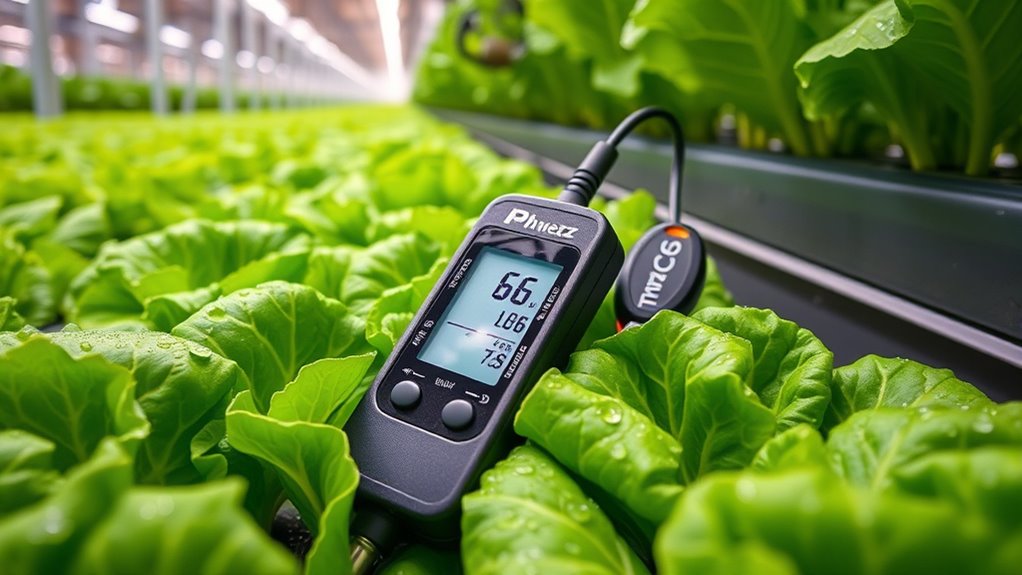
To keep your hydroponic system thriving, you need to regularly record data from your pH meters and EC testers. This helps you adjust nutrient levels before plants show signs of stress. Consistent monitoring guarantees your plants stay healthy and productive day after day. Using accurate testing devices is essential for optimal nutrient balance and plant growth.
Consistent Data Recording
Integrating monitoring tools like pH meters and EC testers into your daily hydroponic routine guarantees you gather accurate data consistently. Regularly recording measurements helps you spot trends and maintain ideal conditions. To keep your system running smoothly, consider these key practices:
- Log pH and EC levels daily to track changes over time
- Use soil testing when necessary to compare with water-based readings
- Maintain water filtration systems to prevent contamination affecting data accuracy
- Keep a dedicated journal or digital record for easy reference and trend analysis
- Understand the importance of monitoring beneficial nutrients to optimize plant health and growth
Consistent data recording ensures you catch issues early, reduce crop stress, and maximize nutrient delivery. This routine streamlines your care process, promotes healthy plant growth, and enhances overall hydroponic success.
Adjusting Nutrient Levels
Once you’ve established a routine for recording pH and EC levels, adjusting nutrient concentrations becomes straightforward. Use your monitoring tools to identify when nutrients are either too concentrated or too diluted. If pH drifts outside the ideal range, adjust your nutrient solution accordingly, guaranteeing plants absorb essential elements efficiently. Regular soil testing can help you understand the overall nutrient balance, guiding more precise adjustments. Keep an eye on pest management, as pests can interfere with nutrient uptake, causing imbalances. When necessary, dilute or concentrate your nutrient solution to maintain proper levels. Consistent adjustments based on your readings ensure your plants receive steady nourishment, promoting healthy growth and preventing deficiencies or toxicities.
Preventing Plant Stress
Incorporating monitoring tools into your daily hydroponic routine helps prevent plant stress before it becomes serious. Regularly checking pH and EC levels ensures your plants aren’t exposed to harmful nutrient imbalances that can lead to plant disease or pest issues. Consistent monitoring helps you catch early signs of stress, allowing prompt adjustments to nutrient solutions or environmental conditions. This proactive approach reduces the risk of pests taking hold or diseases developing. By maintaining ideal growing conditions, you support healthy root development and vigorous plant growth. Remote work techniques such as scheduled checks and record-keeping can improve your overall management of plant health.
- Inspect plants daily for signs of stress or pests
- Adjust nutrient levels based on pH and EC readings
- Clean and disinfect equipment regularly
- Isolate infected plants to prevent disease spread
Benefits of Real-Time Data for Hydroponic Success
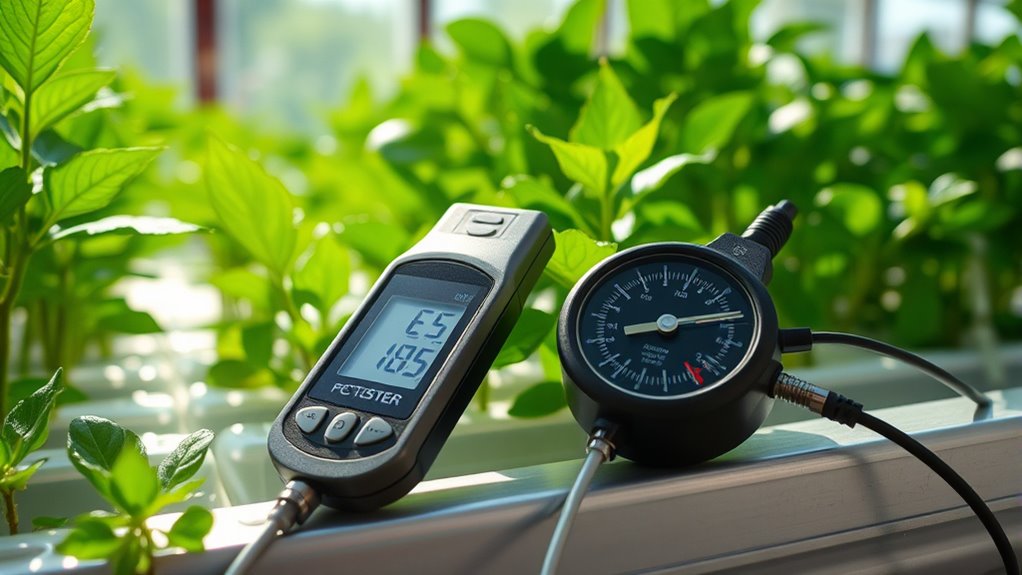
Real-time data from pH meters and EC testers allows you to monitor your hydroponic system continuously, ensuring ideal nutrient levels and pH balance. By tracking pH fluctuation, you can quickly make adjustments to prevent stress and maintain optimal conditions for plant growth. Consistently monitoring EC levels helps achieve EC stability, which is vital for nutrient uptake and preventing deficiencies or toxicities. With immediate feedback, you can respond promptly to any changes, avoiding issues before they impact your plants. This proactive approach maximizes growth potential and reduces the risk of crop loss. Additionally, understanding the importance of nutrient balance in your system can further enhance plant health and productivity. Overall, real-time data empowers you to fine-tune your system efficiently, leading to healthier plants, higher yields, and more reliable hydroponic success.
Frequently Asked Questions
How Often Should I Test My Hydroponic System’S Ph and EC Levels?
You should test your hydroponic system’s pH and EC levels at least twice a week to maintain ideal watering frequency and prevent nutrient deficiencies. Regular testing helps you catch imbalances early, ensuring your plants get the right nutrients. If you notice changes in growth or health, increase testing to daily. Consistent monitoring keeps your system balanced, promoting healthy, vigorous plants and avoiding issues caused by improper nutrient uptake.
Can Inaccurate Readings Harm My Hydroponic Crops?
Yes, inaccurate readings can harm your hydroponic crops. If you don’t monitor correctly, nutrient absorption becomes imbalanced, making it harder for your plants to access essential nutrients. This can lead to poor root health, stunted growth, and even crop failure. Regular, precise testing helps you maintain ideal pH and EC levels, ensuring your plants absorb nutrients properly and stay healthy throughout their growth cycle.
What Are the Signs of Ph and EC Imbalance in Plants?
If your plants start showing extreme signs, it’s likely an imbalance in pH or EC levels. You might see nutrient deficiencies where leaves turn yellow or growth stalls. Water toxicity could cause wilting or root damage. These issues signal your plants struggle to absorb nutrients properly. Regularly checking pH and EC helps prevent these problems, ensuring your crops stay healthy and vibrant, avoiding the chaos of nutritional chaos.
Are Digital Meters More Reliable Than Analog for Hydroponics?
Digital meters often offer better digital accuracy, making them more precise for hydroponic nutrient management. They’re typically easier to read and provide quick results, helping you monitor conditions more effectively. However, analog devices tend to have greater durability, resisting damage from moisture or rough handling. If you want consistent accuracy and durability, choose a digital meter for precise monitoring, but keep an eye on maintenance to ensure longevity.
How Do Environmental Factors Affect Ph and EC Measurements?
Environmental factors like temp fluctuations and light exposure can substantially impact your pH and EC measurements. When temperatures rise or fall, they can cause readings to shift, leading to inaccurate results. Similarly, light exposure can influence sensor performance and water chemistry. To guarantee accurate readings, you should regularly calibrate your meters, keep measurements consistent, and account for environmental changes that may affect your hydroponic system’s nutrient balance.
Conclusion
By consistently monitoring pH and EC levels, you guarantee your hydroponic system stays ideal for plant growth. For example, a grower who regularly checks and adjusts their nutrients saw a 20% increase in yield. When you stay vigilant with these tools, you catch issues early and prevent problems before they harm your crops. Keep monitoring, stay proactive, and watch your hydroponic success thrive.
